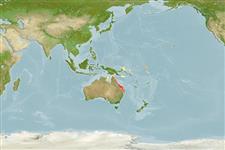>
Ovalentaria/misc (Various families in series Ovalentaria) >
Opistognathidae (Jawfishes)
Etymology: Opistognathus: Greek, opisthe = behind + Greek, gnathos = jaw (Ref. 45335); to the very elongate upper jaw of the type species of the genus, Opistognathus nigromarginatus (Ref. 128653); seminudus: Name from Latin 'semi' for half and 'nudus' for bare or naked, referring to the naked anterior half of the body.
Environment: milieu / climate zone / depth range / distribution range
بوم شناسي
دريايي نزديك كف زي; تغييرات عمق 0 - 22 m (Ref. 76827). Tropical
Western Pacific: Australia.
Size / Weight / سن
Maturity: Lm ? range ? - ? cm
Max length : 8.6 cm SL جنس نر / بدون خواص جنسي; (Ref. 76827)
توصيف مختصر
كليدهاي شناسايي | ريخت شناسي | ريخت ستجي بوسيله انداره گيري
خارهاي باله پشتي (کل) : 10 - 11; شعاع نرم باله پشتي (کل) : 14 - 16; خارهاي باله مخرجي: 2; شعاع نرم باله مخرجي: 14 - 15; مهره ها: 28 - 29. This species is distinguished by the following set of characters: D XI (exceptionally X), 14-16; about 28-36 oblique scale rows in longitudinal series on body; no scales anterolaterally forward of verticals from ultimate spine to 2nd segmented dorsal-fin ray; conspicuous ocellus between spines 2-5 of dorsal fin; 1-3 vomerine teeth (Ref. 76827).
Inhabits coral reef (Ref. 75154).
Life cycle and mating behavior
بلوغ | تولید مثل | تخم ریزی | تخم ها | Fecundity | توزاد ( لارو)
Smith-Vaniz, W.F., 2004. Descriptions of six new species of jawfishes (Opistognathidae: Opistognathus) from Australia. Rec. Aust. Mus. 56:209-224. (Ref. 76827)
وضعيت در فهرست قرمز IUCN (Ref. 130435: Version 2024-2)
خطر برای انسان ها
Harmless
استفاده انسانی
ابزارها
گزارش های ويژه
بارگيری XML
منابع اينترنتي
Estimates based on models
Preferred temperature (Ref.
123201): 24.7 - 28.3, mean 26.7 °C (based on 415 cells).
Phylogenetic diversity index (Ref.
82804): PD
50 = 0.5000 [Uniqueness, from 0.5 = low to 2.0 = high].
Bayesian length-weight: a=0.00389 (0.00180 - 0.00842), b=3.12 (2.94 - 3.30), in cm total length, based on all LWR estimates for this body shape (Ref.
93245).
Trophic level (Ref.
69278): 3.4 ±0.6 se; based on size and trophs of closest relatives
Fishing Vulnerability (Ref.
59153): Low vulnerability (10 of 100).
